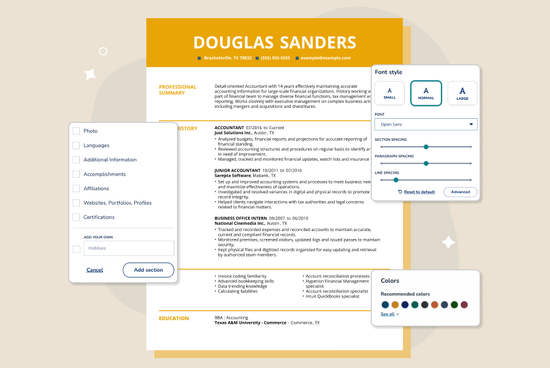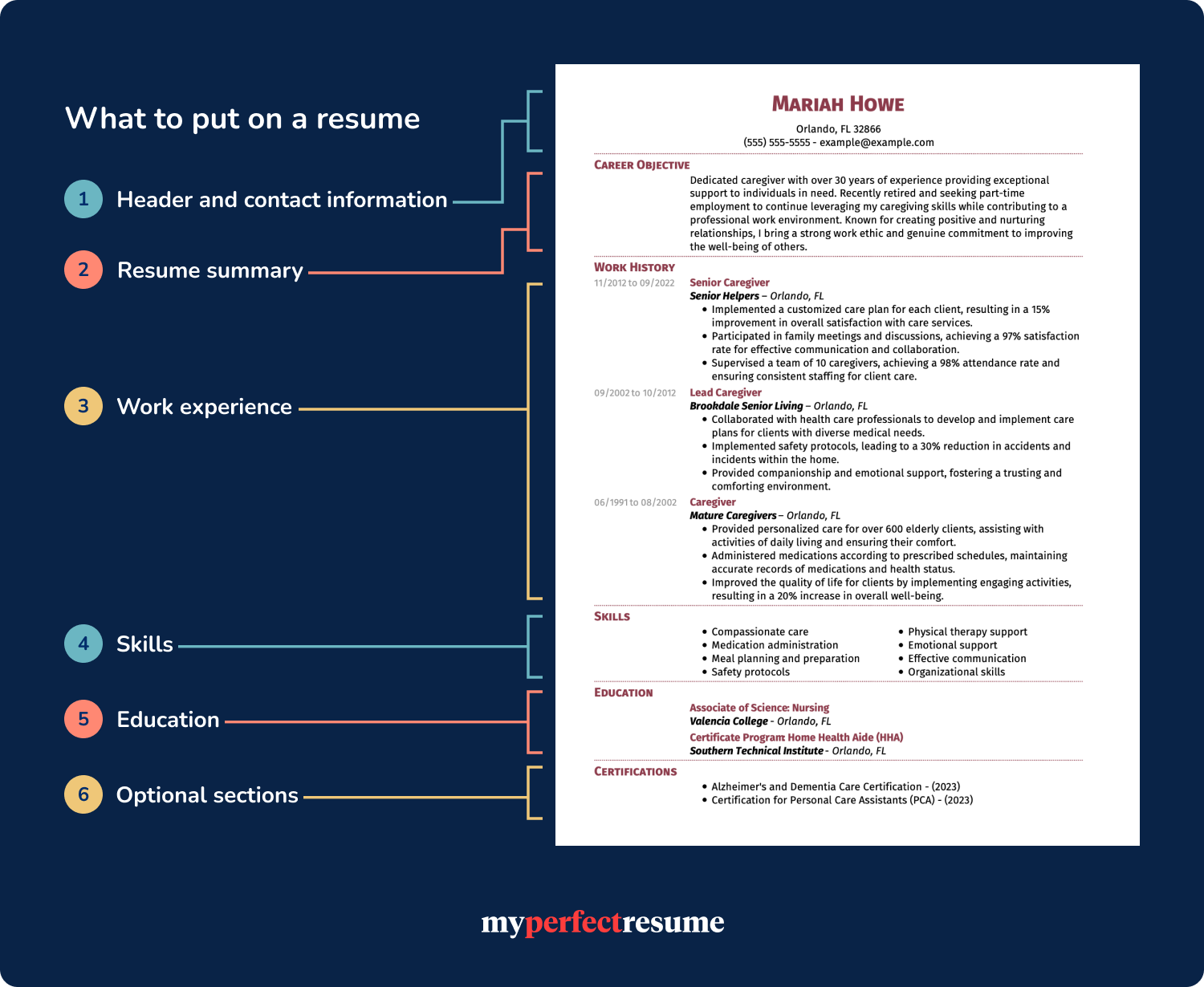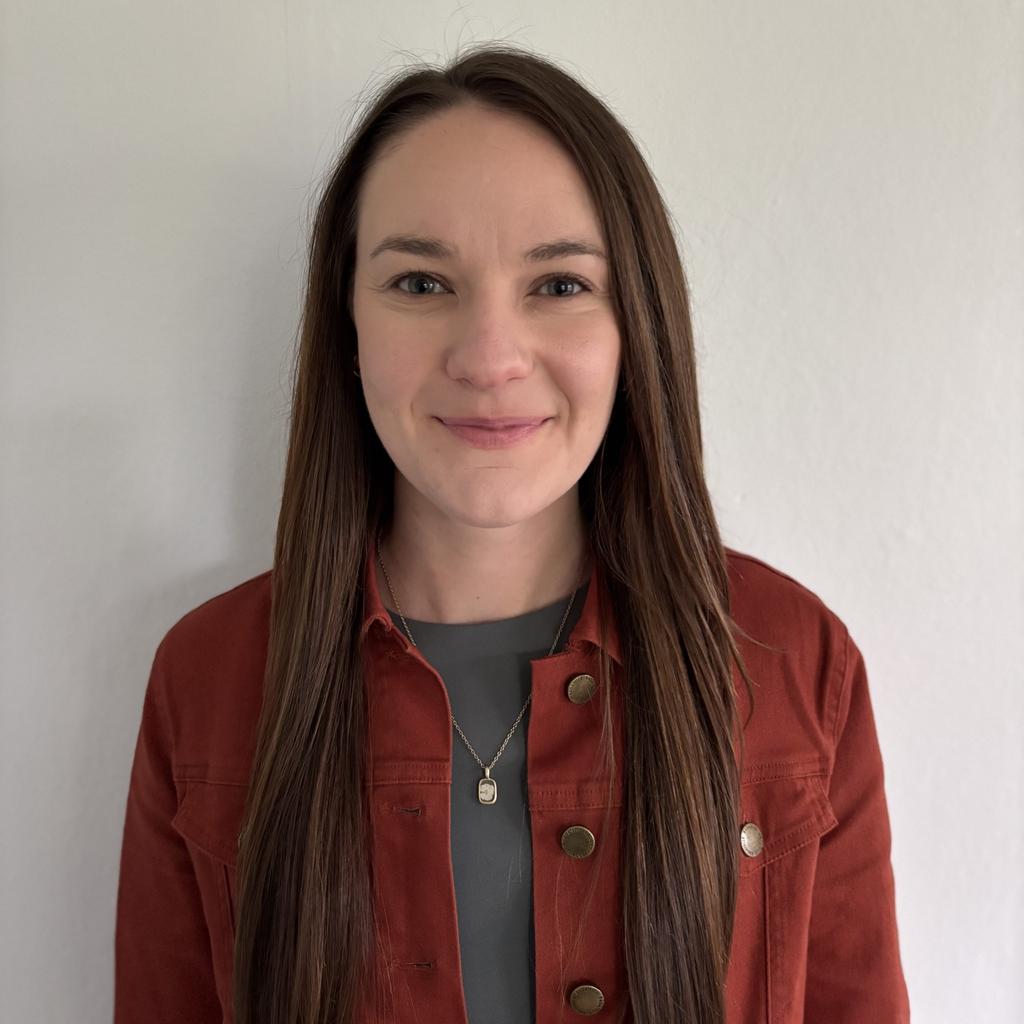What to Put on a Resume in 2025 (Examples + Tips)

Our customers have been hired at: *Foot Note
When it comes to job hunting, your resume is your most important marketing tool. It's the first impression you make on potential employers, and it can determine whether or not you secure an interview.
But what do you need to put on a resume to make it stand out from the competition? Resume best practices are constantly in flux, which can make it tricky to figure out exactly what to include on your resume (and what to leave out).
We'll discuss the key elements that should be included in every resume. Whether you're a recent graduate or a seasoned professional, we have the tips and examples you need to write a resume that gets noticed by employers.
What to put on a professional resume
Depending on your circumstances and the job you are applying for, there may be variations in your resume format, however, all resumes include a few key sections. We’ll discuss the nuances of each section below to help you get started. Take a look at the image below for a snapshot of what to put on a work resume.
Including these sections on your resume ensures that employers get a comprehensive overview of your skills, experiences and qualifications. We’ll discuss the nuances of each section below to help you get started.
PRO TIP
Our professional resume templates come preformatted with all of the sections you need to include in your resume. Easily add your contact information and click to add ready-made content from Certified Professional Resume Writers.
Header and contact information
Including up-to-date contact information on your resume ensures that potential employers can reach you to schedule a job interview.
Add your contact information to your resume header using an easy-to-read font such as Arial, Helvetica or Times New Roman.
Include your name, email, city, state, ZIP code and a link to your professional portfolio or networking profile. Take a look at the example below:
Mariah Howe
555-555-5555 | mhowe@email.com | Orlando, FL 32866 | example@example.com
We recommend exploring our library of 800+ resume examples to see a wide variety of design options for displaying your contact details in the header of your resume.
Resume summary
A resume summary is a brief statement that highlights your key qualifications, skills and experience.
Starting your resume off with a professional summary is a great way to grab the hiring manager’s attention by providing a snapshot of your top skills and qualifications.
A well-crafted resume summary should be concise, specific and tailored to the job you are applying for. Here’s an example of what to put in a summary on a resume:
In some cases, you might decide to use a resume objective instead of a resume summary. Here are some situations where you might use a resume objective:
- You are transitioning into a new field
- You are a student or recent graduate
- You are applying for an entry-level position
- You have extensive gaps in your career history
Take a look at 100+ resume objective examples for additional guidance and inspiration.
PRO TIP
Our Resume Builder offers prewritten resume summaries and objective statements to help you get started.
Work experience
Including a well-crafted and tailored work experience section is essential for demonstrating your career progression and highlighting your qualifications.
Employers often use work history to assess your suitability for the job and to determine whether you have the necessary skills and experience to succeed in the role. Here’s an example of what to include in a work history entry:
Marketing Coordinator
ABC Company, New York, NY
Jan. 2018 - Present
- Collaborate with cross-functional teams to develop and execute marketing campaigns that increase brand awareness and drive leads.
- Manage social media accounts, creating engaging content and growing the company's online presence.
- Conduct market research and analyze data to identify trends and opportunities for growth.
If you are listing a job at a lesser-known company, you can add a one-sentence description directly underneath the company name describing what it does. This can help give employers a better understanding of your professional background.
Skills
By including a strong skills section on your resume, you can demonstrate that you have the qualifications needed to excel in the role.
Remember to tailor your skills section to the job description and highlight the skills that are most important to the employer.
See out Google resume examples for samples of resumes tailored to a specific employer's values.
Your skills section should include a mix of hard skills and soft skills. Here's an example of a skills section for a marketing professional:
Skills
- Email marketing
- Project planning
- A/B testing
- Marketing automation
- Budgeting
- Stakeholder management
- Google Analytics
You might choose to put more emphasis on your technical skills or on your interpersonal skills, depending on your field and the job description at hand.
Education
The education section of your resume should include information about your academic background, such as your degree, minor and any relevant coursework or training.
Include the name and location of the school or institution and the degree or program you completed. It is not necessary to include your graduation year, however, you can do so if you graduated in the past three years.
List your educational experiences in reverse chronological order, with your most recent degree or program listed first. Here’s an example of what to put in the education section of your resume:
Education
University of California, Los Angeles - Los Angeles, CA
Bachelor of Science in Business Administration, Marketing
Relevant coursework: Principles of Marketing, Consumer Behavior, Marketing Research, Digital Marketing, Social Media Marketing, Advertising and Promotion
Honors: Dean's List (Fall 2018, Winter 2020, Spring 2021)
If you are currently pursuing a degree or program, you can list your expected graduation date instead of the actual date of completion.
Optional resume sections
In addition to your work experience, education and skills, you can also consider including optional sections on your resume to further showcase your qualifications and enhance your candidacy.
Certificates and licenses
You might consider including a section on job-relevant certifications or licenses you have received. Here’s an example of how to put certifications on a resume:
Certifications
- Project Management Professional (PMP), Project Management Institute, 2020
- Certified Public Accountant (CPA), State Board of Accountancy, 2019
Here are some additional tips on how to list certifications and licenses on your resume:
- List them in reverse-chronological order: List your certifications and licenses in reverse chronological order, starting with the most recent.
- Include the name and organization: For each certification or license, include the name of the certification or license and the organization that granted it.
- Mention the date of certification: Include the date you obtained each certification or license.
Volunteer experience
Including volunteer experience on your resume can demonstrate your commitment to causes you care about and show potential employers that you are a well-rounded candidate with a variety of experiences.
Create a separate section for relevant volunteer experience rather than listing it in your work history section. Here’s an example:
Volunteer Experience
Habitat for Humanity, Volunteer Builder
June 2019 - Present
- Assisted with the construction of new homes for low-income families
- Worked with a team of volunteers to complete tasks such as framing, roofing and installing windows
- Participated in safety training and enforced safety procedures on the job site
Remember to include the name of the organization, your role and the dates of your involvement. Highlight any skills you developed or demonstrated, such as leadership, teamwork or communication.
Language proficiencies
Adding language proficiencies on your resume can be a valuable asset, especially if the job requires communication with people who speak a different language.
When listing language proficiencies, it's important to be honest about your skill level and to use terms like "beginner," "intermediate," "advanced" or "fluent" to describe your level of proficiency. Here’s an example of how to list languages on your resume:
Languages
- English — Fluent
- French — Intermediate
- Spanish — Advanced
Additionally, if you have any experience using the language in a professional setting, such as translation or interpretation, be sure to include that as well.
Awards and honors
By including awards and honors on your resume, you can demonstrate your achievements and highlight your strengths to potential employers. Here is an example for inspiration:
Awards
- Best Salesperson of the Year, XYZ Corporation, 2019
- Outstanding Volunteer Award, ABC Community Center, 2018
- Best Paper Award, National Conference on XYZ Studies, 2016
Examples of awards and honors that you might include in this section of your resume include academic honors, professional awards, industry certifications, scholarships, fellowships and community service awards.
Hobbies and interests
The right hobbies on your resume can add depth to your work experience, help highlight your job-relevant skills and show employers how you might fit into the organization’s culture. Here's an example:
Interests
- Photography: Developed an eye for detail and composition through capturing moments in nature and urban environments.
- Volunteer Work: Actively involved in community service projects, demonstrating dedication and commitment to making a positive impact.
- Cooking: Passionate about experimenting with new recipes and flavors, fostering creativity and problem-solving skills in the kitchen.
Make a resume with MyPerfectResume
Our Resume builder can help you write the perfect resume. Start Now!
What not to put on a resume
There are certain things that should not be included on your resume. In order to help you avoid common mistakes, we have compiled a list of things that you should avoid putting on your resume.
- Personal information beyond your name, phone number, email address and location. This includes things like your home address, social security number and date of birth.
- Unprofessional email addresses or usernames. Make sure your email address is appropriate and professional.
- Shortened or nicknames for your name. Use your full name or the name you go by professionally.
- Professional references. Provide professional references later in the hiring process, after the hiring manager has reviewed your application and conducted interviews.
- Multiple phone numbers or email addresses. Stick to one phone number and one email address that you check regularly and are professional.
- Social media handles or links to personal websites unless they are relevant to the job you are applying for.
By avoiding these pitfalls, you can ensure that your resume is professional, relevant and effective in helping you land the job you want. For additional guidance, take a look at the resume examples below.
Examples of what to put on student resumes
Explore the professionally made resume examples below for ideas of what to put on a resume throughout the various stages of your educational journey.
Examples of what to put on a professional resume
Check out the professional resume examples below for ideas of what to include on your resume. See what should a resume look like for additional guidance from career advice experts.
What to put on a resume key takeaways
- Include up-to-date contact information on your resume, including your name, email address and phone number.
- Add a compelling summary or objective statement to grab the attention of the hiring manager.
- Use strong action words, measurable achievements and keywords from the job description when describing your work experience.
- Include a mix of hard skills and soft skills on your resume, and tailor your skills section to the job you are applying for.
- Ensure that any educational accomplishments, certifications and volunteer work you include on your resume are relevant to the job you are applying for.
- Do not put unnecessary personal information, unprofessional language or irrelevant information on your resume.
FAQ
What do you put on a resume with no work experience?
Wondering what to put on a resume for your first job? If you are writing a resume with no work experience, there are several things you can include on your resume to showcase your skills, achievements and qualifications. Here are some ideas:
- Objective statement: Start your resume with a clear objective statement that highlights your career goals and what you hope to achieve in your desired position.
- Education: List your educational qualifications, including your degree, school and any relevant coursework or projects.
- Extracurricular activities: Include any extracurricular activities or volunteer work that you have done that demonstrate your leadership, problem-solving skills or teamwork.
- Projects: If you have completed any projects, either in school or independently, that are relevant to the job you are applying for, include them on your resume and describe your role and achievements.
- Professional development: If you have participated in any training programs, workshops, or seminars, include them on your resume to demonstrate your commitment to learning and professional development.
By including these sections on your resume, you can demonstrate your qualifications and showcase your potential as a candidate, even if you don’t have any work experience.
What are good skills to put on a resume?
There are many skills to put on a resume, depending on the job you are applying for and your own qualifications and experience. Here are ten examples of skills that are relevant for most jobs:
- Communication: Verbal and written communication, active listening and interpersonal skills.
- Teamwork: Collaboration, cooperation and conflict resolution skills.
- Problem-solving: Critical thinking, analytical reasoning and creativity.
- Time management: The ability to prioritize tasks, meet deadlines and manage multiple projects.
- Leadership: The ability to motivate and inspire others, delegate tasks and resolve conflicts.
When listing skills on your resume, make sure to provide specific examples of how you have demonstrated these skills in previous roles or experiences. This will help to demonstrate your qualifications and showcase your potential as a candidate.
Should you put your high school on your resume?
In most cases, it is not necessary to include your high school on your resume, especially if you have completed a college degree or higher education. However, there are a few exceptions when including high school information that may be relevant:
- Limited work experience: If you are a recent high school graduate with limited work experience, including your high school information may be helpful to showcase your academic achievements and extracurricular activities.
- Job requirements: If the job posting specifically asks for high school information, then you should include it in your resume.
- Relevant achievements: If you have achieved academic or extracurricular achievements in high school that are relevant to the job, such as winning a national competition or participating in a relevant club or organization, then you may want to include this information.
In most cases, however, it is more important to highlight your college education, job experience and relevant skills on your resume. See our high school graduate resume examples if you are a recent graduate.
How many jobs should I put on my resume?
In general, it is recommended to include the most recent 10-15 years of work experience on your one-page resume or two-page resume. However, if you have a long work history with many jobs, you may want to focus on the most relevant and recent positions.
If you are a recent graduate or have limited work experience, you may want to include all of your relevant work experience to showcase your skills and qualifications. On the other hand, if you have several years of experience and have held many positions, it may be more effective to focus on the most relevant experiences and highlight your achievements in those roles.
Ultimately, the goal of your resume is to showcase your relevant experience and skills to the employer, so you should only include information that is relevant to the job you are applying for.
How do you include keywords in a resume?
Many employers use applicant tracking systems (ATS) to scan resumes for keywords such as skills, job titles or areas of experience.
Including keywords from the job description in your work history section is an effective way to ensure that your resume gets past ATS and into the hands of hiring managers.
Let’s say the job description for a marketing coordinator position includes the following requirements: “Experience managing social media accounts and creating engaging content for Facebook, Twitter and Instagram.“
To incorporate this keyword into your work history section, you could include a bullet point that reads, “Managed social media accounts, including Facebook, Twitter and Instagram, creating content that increased engagement by 25%.”
We also recommend exploring our resume About Me examples for guidance on incorporating keywords into the introductory paragraph on your resume.
What do you put on a resume to make it ATS-friendly?
There are a number of steps you can take to make an ATS-friendly resume, such as:
- Include keywords from the job description through your resume.
- Stick to a simple, easy-to-read layout with standard fonts and a clean design.
- Avoid using images, graphics or other design elements that may confuse the ATS.
- Use standard section headings, such as “Work Experience,” “Education” and “Skills,” to make it easier for the ATS to scan your resume.
- Use bullet points to break up your text and highlight your key achievements and responsibilities. This will make your resume easier for the ATS to scan (and for people to read).
Use our free ATS resume checker to grade your resume and receive personalized feedback on how to optimize it for applicant tracking systems.
What are some action words to put on a resume?
By using strong and specific action words throughout your resume, you can show that you are a proactive and results-driven candidate who is ready to make an impact in your next role.
Here are a few examples of impactful action words to put on your resume:
- Adapt
- Coordinate
- Direct
- Facilitate
- Generate
- Improve
- Launch
- Manage
- Increase
- Maximize
Remember to tailor your work experience bullet points to the job you are applying for. A targeted resume that focuses on relevant work experience is much more likely to get noticed by recruiters and hiring managers.
How do you put measurable achievements on a resume?
The work history section of your resume should include measurable achievements that provide concrete evidence of your skills and abilities.
Here are a few examples of measurable achievements to put on a resume:
- Increased sales revenue by 20% over the course of one year.
- Managed a team of 10 employees and achieved a 90% employee satisfaction rating.
- Reduced customer complaints by 50% through the implementation of a new customer service strategy.
- Achieved a 95% on-time delivery rate for a supply chain of 500+ vendors.
- Negotiated a new contract that saved the company $100,000 in annual expenses.
Having trouble deciding how to describe your work experience and achievements? Using an AI resume builder takes the guesswork out of this process.
What are good soft skills to put on a resume?
In addition to technical skills and work experience, employers often look for candidates who possess strong soft skills. These are personal attributes that enable individuals to work effectively with others and contribute to a productive work environment.
Here are some soft skills that you can put on your resume:
- Communication
- Leadership
- Teamwork
- Adaptability
- Problem-solving
- Time management
- Creativity
- Attention to detail
By putting soft skills on your resume, you can demonstrate your ability to work well with others, adapt to new situations and solve problems effectively.
What are some hard skills you can put on a resume?
Hard skills refer to technical abilities and knowledge that are learned through education, training or experience. They are specific and measurable skills that are relevant to the job or industry you are applying for.
Here are some examples of hard skills for a resume:
- Programming languages (e.g. Java, Python, C++, etc.)
- Database management (e.g. MySQL, Oracle, SQL Server, etc.)
- Web development (e.g. HTML, CSS, JavaScript, etc.)
- Graphic design (e.g. Adobe Creative Suite, Canva, etc.)
- Project management (e.g. Agile, Scrum, Waterfall, etc.)
- Data analysis (e.g. Excel, SAS, R, etc.)
- Financial analysis (e.g. budgeting, forecasting, financial modeling, etc.)
- Marketing skills (e.g. SEO, SEM, PPC, social media marketing, etc.)
- Technical writing (e.g. creating user manuals, technical reports, etc.)
Remember to tailor your list of hard skills to the specific job or industry that you are applying for and back up your skills with examples of how you have used them in your past work experiences.
How we reviewed this article
Since 2012, we have helped more than 11 million job seekers. We want to make your career journey accessible and manageable through our services and Career Center’s how-to guides and tips. In our commitment to bring you a transparent process, we present our Editorial Process.
Sources
- Columbia University Center for Career Education. Article. Your Resume: What to Put In, What to Leave Out
- CareerSidekick. Article. Clark, Biron. What to Put on a Resume: 9 Things to Include
- Robert Half. Article. Skills to Put on a Resume Employers Will Actually Read (With Examples)
- Coursera. Article. How to Write a Resume with No Experience: 5 Tips
- Harvard Business Review. Article. Cohen, Paige. How to Write a Resume That Stands Out
Our customers have been hired at:*Foot Note








